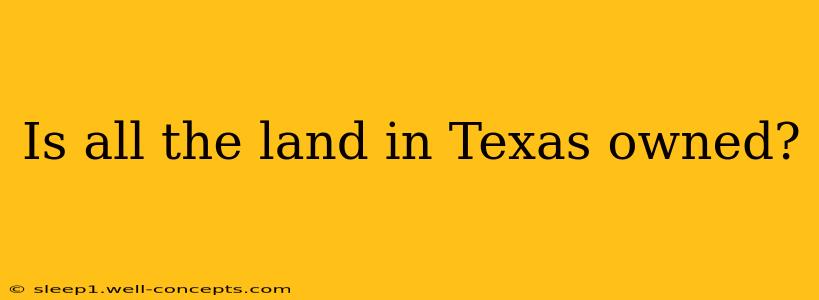The question of whether all land in Texas is owned is a surprisingly complex one, far exceeding a simple yes or no answer. While the vast majority of Texas land is privately owned, the reality is nuanced, involving a blend of private, state, and federal holdings, along with unique historical and legal considerations. This article will delve into the intricacies of Texas land ownership, dispelling common misconceptions and providing a clearer picture of this fascinating aspect of the Lone Star State.
The Myth of Public Land in Texas
A common misconception is that Texas has vast tracts of unclaimed or public land. This is largely untrue. Texas, unlike many other states, doesn't have a significant amount of federally owned land within its borders in comparison to its overall size. While there are national parks and forests (like Big Bend National Park and the Davy Crockett National Forest), these represent a relatively small fraction of the state's total land area.
The vast majority of land in Texas is privately owned, a legacy of the state's history and land grant system. This private ownership dates back to the Spanish colonial era and continues to shape land use and development today.
The Role of the State and Federal Governments
While the majority is privately held, the state and federal governments still own considerable land in Texas, although proportionally less compared to other states. This land is often dedicated to specific purposes:
State-Owned Land:
- State Parks: Texas boasts a network of state parks offering recreational opportunities and preserving natural resources.
- Wildlife Management Areas: These areas are managed for wildlife conservation and hunting.
- School Lands: A significant portion of state-owned land is dedicated to funding public education.
Federally-Owned Land:
- National Parks and Forests: As mentioned earlier, these are crucial for conservation and tourism.
- Military Installations: Several military bases occupy considerable land areas within the state.
- Other Federal Holdings: The federal government also holds land for various purposes, including research and resource management.
The Private Ownership Landscape: A Diverse Picture
The privately owned land in Texas is far from homogenous. It ranges from sprawling ranches encompassing thousands of acres to smaller plots in urban areas. The history of land grants and subsequent subdivisions has created a complex patchwork of ownership patterns.
Many Texas landowners hold their property under different types of deeds and titles, adding another layer of complexity to understanding overall ownership. These variations often reflect the historical context of land acquisition and subsequent transfers.
Unclaimed Land? The Reality
While the concept of "unclaimed land" is alluring, the reality is quite different. Any land not demonstrably owned by an individual or entity would fall under the jurisdiction of the state of Texas. The Texas General Land Office actively manages and surveys state-owned land and processes claims as needed. Claims of unowned land are rare and require extensive legal and historical research to prove.
Conclusion: A Complex but Largely Private Landscape
In conclusion, the statement "all land in Texas is owned" is essentially true, albeit with important qualifications. The majority of Texas land is under private ownership, a product of the state's unique history. However, significant portions are also held by state and federal entities for various public purposes. The notion of large tracts of unclaimed land is a misconception, with the state actively managing any land without a clear owner. Understanding the nuances of Texas land ownership requires exploring the state's rich history and its evolving legal frameworks.

